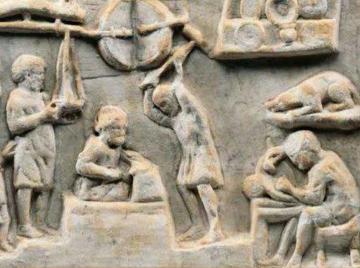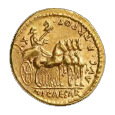ESF Exploratory Workshop: Craftsmen and Traders in the Roman World
This interdisciplinary workshop brings together, for the first time, leading European specialists studying Roman craftsmen and traders. The study of this topic is currently quickly developing: new theoretical perspectives and methodological approaches are transforming our insight into the social and professional strategies of craftsmen and traders, and are enhancing the significance of everyday work for Roman social and economic history in general. Yet, the field is still rather divided along national and disciplinary lines. This workshop, and follow-up collaborations such as a conference series and reference works, will foster debate across these lines, maximizing the impact of current developments.
An emerging field
The aim of the ESF workshop is to bring together scholars from all over Europe working on urban craftsmen and traders in the Roman world in order to discuss current developments in this research field and the possibilities for future collaboration. The current amount of interest in Roman craftsmen and traders, and the consequent rapid evolution of scholarly ideas about their social and economic history, suggest that a better collaboration between scholars working on these issues might yield significant results for our understanding of the cities of the Roman world in general.
The Roman era is a crucial period for the history of urbanism: it is a period of unprecedented urbanization and urban expansion in the Mediterranean, as well as a period in which for the first time, urban settlements appeared in large parts of present-day Europe. It also constitutes the oldest period from which a considerable body of comparable material and written evidence has been preserved and documented across a large region, and the quality of this evidence exceeds that of earlier periods. Crucial to our interpretation of the cities in the Roman world and their position in the history of urbanism is our view on the socioeconomic functioning of these urban societies. As in any preindustrial society, people producing and trading everyday commodities played a defining role in Roman urban communities, socially, spatially and economically. The social and economic contexts in which crafts and trade took place, the patterns of investment related to them, and the levels of technological and economic sophistication on which craftsmen and traders operated thus are essential in understanding how Roman cities worked, and should be at the heart of the debate about their social and economic history.
For a number of reasons, however, craftsmen and traders have long played a rather marginal role in ancient history and classical archaeology. Scholars of the Roman world have traditionally focused strongly on urban and imperial elites and on the monumental mark they left in the material and written records. Craftsmen and traders were often overlooked and not generally very highly thought of: there have been vociferous schools in the social and economic history of the Roman world who have thought of these people as socially marginal and, economically, of little significance. Echoes of these ideas still figure prominently in many present-day handbooks on the Roman world. Fortunately, however, the last fifteen years have seen a remarkable increase in scholarly interest in the subject. Several trends have developed alongside one another: there is a new wave of interest among Latin and Greek epigraphists in the history of professional associations of Roman craftsmen and traders; papyrologists are increasingly exploring the possibilities of documentary evidence for the craftsmen of Roman Egypt; more than ever before, classical archaeologists are closely scrutinizing the material remains of shops and workshops, and their analytical focus is moving beyond the mere identification of these establishments to their social, spatial and economic contexts. Previously neglected data sets are being studied for the first time, and those that have been studied before are being approached in more critical ways.
As a result, the study of craftsmen and traders is currently in a phase of unprecedented development, which is changing as well as deepening our understanding of the economic roles of crafts and trade in Roman cities and the position of the people involved in it in their urban communities. Independently of each other, scholars are increasingly challenging traditional ideas about the low social status of craftsmen and traders and about their dependence on local elites, embracing models that leave more room for the perspectives and decisions of these people themselves. There is also an increasing awareness of the presence of women in the world of Roman craftsmen and traders and, consequently, there is an increasing interest in the role of gender distinctions in everyday business. In a similar way, notions about the economic marginality of crafts and trade and technological backwardness of Roman manufacturing processes are being replaced by more nuanced and sophisticated alternatives that put more emphasis on the economic strategies followed by those involved in crafts and trade and, in the case of crafts, on the technological developments that were embraced by them, instead of those that were not.
These developments are greatly enhancing the relevance of craftsmen and traders for the social and economic history of the Roman world in general: scholars of the Roman economy are rediscovering the relevance of studying crafts and their technologies as well as trade and its strategies for our understanding of the structure and performance of urban economies in the Roman world; Roman social and cultural historians are increasingly interested in using the perspective of common people like craftsmen and traders as an alternative way of approaching Roman society.
Towards Europe-wide collaboration
Yet, as in many emerging fields, the scholarly discussion on Roman craftsmen and traders suffers from a lack of infrastructure and integration: there are no truly international research networks, journals or conference series that provide a platform for debate, and the scholarly field is still rather divided along disciplinary and national lines: debates on crafts and manufacturing in the Anglo-Saxon world, France, Germany, Italy and other countries function almost completely independently of each other. At the same time, there is only limited interaction between epigraphists, archaeologists and papyrologists. Among archaeologists, moreover, there is a big divide between classical archaeologists working in the Mediterranean cities, and Roman provincial archaeologists, working on material from north-western Europe. This lack of integration is reflected in scholarly literature. For example, papers in the only journal specifically focusing on ancient crafts and trade, the Münstersche Beiträge zur Antiken Handelsgeschichte, are, after 25 years, still mostly written by German ancient historians; similarly, the discussion in the many conference proceedings on ‘l’artisanat romain’ in France is almost completely dominated by French archaeologists.
As a result, the scholarly field is rather fragmented, and a comparative perspective is lacking: people working on Roman crafts and trade do not easily get to know each other, often work in relative isolation, and only engage with each other’s work to a limited extent. Scholars publish in a wide variety of journals, and not always in journals that are very well spread internationally. Apart from some encyclopedias from the 19th and early 20th centuries, there are no standard works of reference. Hence, it is safe to say that the amount of scholarly interaction on Roman craftsmen and traders is not yet reflecting the recent increase in scholarly interest in the subject. This not only obstructs innovation and cross-fertilization among scholars studying Roman craftsmen and traders, but also affects the visibility of what is happening to non-specialists, and, consequently, the wider dissemination of current developments. Typically, recent handbooks like the Cambridge Economic History of the Greco-Roman World (2007) have no chapter specifically focusing on craftsmen and traders.
Europe-wide collaboration across traditional lines of division is essential to get the academic debate on craftsmen and traders to the next stage, and to enable it to overcome its present-day shortcomings. In the process of setting up such collaboration, the proposed ESF exploratory workshop would play a central and indispensable role in bringing people together and confronting them with each other’s work. While there have been several small conferences and workshops on crafts and craftsmen over the last decade, most took place within national research networks, especially in France and the UK, or, alternatively, within international research networks focusing on one specific trade, such as, most prominently, textiles. The workshop proposed here would be the first to cast the net really wide and will include leading and emerging scholars from all relevant national traditions who are specialists in a wide range of crafts and trades. Moreover, a wide range of historical and archaeological disciplines within which Roman crafts and trade are investigated will be represented, and a large part of the Roman world will be covered. This will be a big step forward: the variety of traditions, data-sets and contexts that will play a role in the workshop, and the natural tension between text-oriented and archaeological approaches, will not only give the workshop a truly interdisciplinary character, but will also result in a cross-fertilization across national boundaries and disciplinary division lines.




